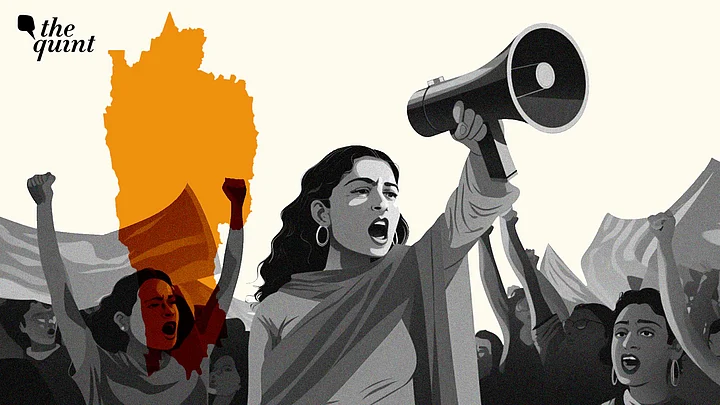In almost a decade, there has been no woman MLA in Mizoram, a state which will see voting for the Assembly elections tomorrow on 7 November. Even though the number of women being fielded in the state elections has increased over the years, women's political representation remains low, evidently.
As the current woman candidates gear up to fight the electoral battle, several odds are stacked against them. Among the 174 candidates in Mizoram that have filed their nominations for the upcoming polls, 15 are women.
It must be noted that there were 16 women candidates in the fray, but the BJP replaced its female candidate in one of the constituencies bringing the number down to 15, according to Northeast Live.
The 40-member state Assembly currently does not have a single woman legislator and has seen only four women MLAs since its formation.
This year, among the women candidates, three are from the BJP, and two each are from the ruling Mizo National Front (MNF), Congress and Zoram People's Movement (ZPM) while others are contesting independently.
Women Candidates & Voters
Let's take a look at some statistics. Mizoram has over 25,000 more women voters than the men. According to the Census, literacy rate stands among men stand at 93.35% while for women it stands at 89.27%.
According to the Chief Electoral Officer's office, Mizoram, there are 8,52,088 voters including 4,12,969 men and 4,38,925 women will exercise their franchise in 1,276 polling stations.
Women voters in Mizoram differ a great deal from men on various aspects such as media exposure, employment and ownership of assets, as per the National Family and Health Survey (2019-21).
Meanwhile, MNF supremo Zoramthanga is re-contesting from the Aizawl East-1 seat, BJP state chief Vanlalhmuaka is contesting from Dampa seat, Congress' Mizoram unit chief Lalsawta is in fray from Aizawl West-III constituency. ZPM president Lalduhoma is seeking re-election from Serchhip seat.
Recently, Congress candidate for Mizoram Assembly elections, Miriam L Hrangchal, who was opposed by a local students' union for marrying a person from outside the Mizo community has claimed that the resistance was "influenced" by her opponent political parties.
Hrangchal married local resident Dipen Zoliana, who belonged to the Gorkha community but has adopted Christianity and Mizo identity.
"Some political parties supported MZP, (a student organisation) and there was political influence to oppose my candidature. They are a pressure group. There will be pressure groups and NGOs who will express their opinion, but that does not necessarily mean they will change things politically," Hrangchal who is contesting elections for the first time, told PTI.
The 4 Women MLAs in Mizoram's History
Let's take a look at the four MLAs Mizoram's Assembly has had till now over the years.
The first woman legislator to be elected in Mizoram was L Thanmawii in 1978. She was born in 1920 in Mizoram, during British rule in India. Thanmawii was elected from Serchhip constituency in 1978 as a nominee of the People's Conference. She was re-elected from Aizawl East assembly constituency in 1979. Mizoram then was a union territory, before it got statehood in 1987.
K Thansiami from Mizoram's People's Conference was elected in 1984 from Aizawl West 1.
Lalhlimpuii Hmar who contested on a Mizo National Front ticket, won the Aizawl North-I seat, bagging 2,326 votes in 1987. Later, she was inducted into the Laldenga Cabinet and became Mizoram's first woman minister with the Minister of State for Social Welfare portfolio.
In 2014, Congress' Vanlalawmpuii Chwangthu won the bye-polls from Hrangturzo and was made a minister by the Congress government. She became the second woman in Mizoram to be inducted in the state's council of ministers after a gap of nearly 30 years. She lost her seat in 2018 Assembly polls.
While in 1998, all the ten women contestants lost their deposits, in 2003, six out of the seven women candidates lost it. In the 2008 elections, six out of the nine contestants forfeited their deposits, while in the 2013 polls, four out of the six candidates met with the same fate.
In an interview with the Deccan Herald, K Vanlalruati, BJP leader who joined the party in 2016 said:
"Women MLAs are rare to find in Mizoram, and the reason is that Mizos have a male-dominated society. Women don't get a place for top positions in NGOs and church denominations. That's why, it is difficult for women even in the political arena. Our society, NGOs and churches also don't take the initiative for women candidates in elections."
Political analysts have often attributed the failure of women to win assembly polls to the Mizo society being vehemently patriarchal and the major political party’s refusal to field women candidates.
Some of the other statistics worth noting from NFHS-5 data that reveal how women voters fare in society:
99% of married women participate in at least three household decisions.
82% women have mobile phones they use.
81% women have a bank account or savings account of their own.
21% own a house or a land (alone or jointly with others).
19% of men and 26 percent of women are not regularly exposed to print media or other forms of media.
95% percent of female respondents and 97% of men belong to Scheduled tribes.
The counting of votes will take place on 3 December.
(At The Quint, we question everything. Play an active role in shaping our journalism by becoming a member today.)
